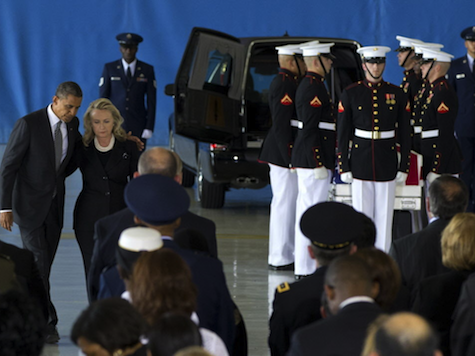The Weekly Standard has obtained “a timeline briefed by the Office of the Director of National Intelligence detailing the heavy substantive revisions made to the CIA’s talking points”–evidence that the talking points used by UN Ambassador Susan Rice were heavily edited by senior members of the Obama administration to hide the role of Al Qaeda in the attack on the U.S. consulate in Benghazi, Libya on the evening of Sep. 11, 2012.
Already, the House of Representatives report on the Benghazi attack referred to a series of emails “between top administration and intelligence officials” that were not included in the report itself but that were merely referred to, as part of a deal with the Obama administration to secure the confirmation of new CIA Director John Brennan. The emails reveal that officials “engaged in a wholesale rewriting of intelligence assessments.”
As Weekly Standard senior writer Stephen F. Hayes notes, the emails are evidence that the administration knew from an early stage–two hours into the attack–that “al Qaeda-linked terrorist group operating in Libya” was responsible. That information was known throughout various government agencies. And yet, by Sunday, Sep. 16, the story had been transformed into the now-infamous lie about an anti-Islam YouTube video.
Hayes presents three versions of the talking points to show the editing process. The first version, prepared by the CIA’s Office of Terrorism Analysis on Sep. 14, suggested that the attack was a “spontaneous” response to the protests at the U.S. embassy in Cairo, Egypt but added that “we do know that Islamic extremists with ties to al Qa’ida participated in the attack” and mentioned several other recent attacks in Benghazi.
The CIA made some modifications to that draft to tone down references to Al Qaeda. Yet a State Department official–who the Weekly Standard claims was spokesperson Victoria Nuland–raised concerns. More changes were made, but Nuland was not satisfied, and White House officials–including presidential adviser Ben Rhoades, according to the Weekly Standard–became directly involved in the editing process.
The second draft–prepared on Sep. 15, the Weekly Standard says, by CIA Deputy Director Mike Morrell–eliminated the references to “jihadists” and “Islamic extremists,” as well as references to previous attacks in Benghazi. The changes removed any hint of the administration’s possible failure to ignore previous warnings of the danger in eastern Libya, as well as any sense that the government knew Al Qaeda had been involved.
The third and final draft, circulated later that day, suggested that “extremists” had participated in the attack on the consulate but described their involvement solely as a result of protests inspired by the protests in Cairo, leaving no indication that the attack was connected to terror organizations or previous assaults. It was that version, apparently, that allowed the White House to fill in the gap with the false video alibi.
Later, Hayes recounts, when the video story began to unravel, the administration issued a statement through the Office of the Director of National Intelligence that suggested that new information had come to light about the role of terrorists in the attack. Yet the information was not new; it had been known from the very earliest stages of the attack. The Weekly Standard’s report suggests a deliberate attempt to deceive the nation.
The Obama administration has not yet made the email record of its discussions of the talking points fully available to Congress. Contrary to the protestations of former Secretary of Defense Hillary Clinton, those emails make a great difference to determining what went wrong on Sep. 11, how to fix it–and whom to hold responsible.

COMMENTS
Please let us know if you're having issues with commenting.